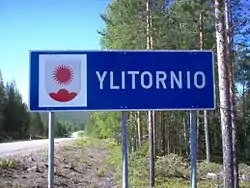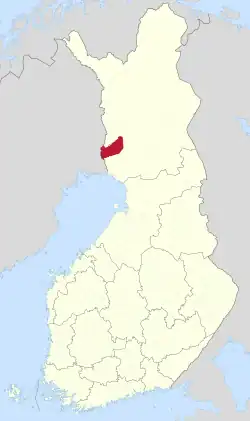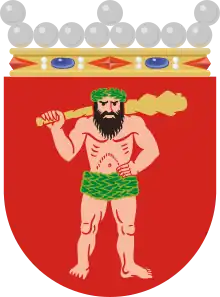Ylitornio
Ylitornio (Swedish: Övertorneå; Northern Sami: Badje-Duortnus; Inari Sami: Pajetuárnus) is a municipality of Finland.
Ylitornio
Övertorneå Badje-Duortnus Pajetuárnus | |
|---|---|
Municipality | |
| Ylitornion kunta Övertorneå kommun | |
 Ylitornio welcome sign | |
 Coat of arms | |
 Location of Ylitornio in Finland | |
| Coordinates: 66°19′N 023°40′E | |
| Country | |
| Region | Lapland |
| Sub-region | Tornio Valley |
| Charter | 1809 |
| Government | |
| • Municipal manager | Maija Pihlajamäki |
| Area (2018-01-01)[1] | |
| • Total | 2,212.47 km2 (854.24 sq mi) |
| • Land | 2,028.86 km2 (783.35 sq mi) |
| • Water | 183.83 km2 (70.98 sq mi) |
| • Rank | 29th largest in Finland |
| Population (2023-10-26)[2] | |
| • Total | 3,754 |
| • Rank | 197th largest in Finland |
| • Density | 1.85/km2 (4.8/sq mi) |
| Population by native language | |
| • Finnish | 96.3% (official) |
| • Swedish | 0.7% |
| • Sami | 0.1% |
| • Others | 2.9% |
| Population by age | |
| • 0 to 14 | 9.8% |
| • 15 to 64 | 51.6% |
| • 65 or older | 38.5% |
| Time zone | UTC+02:00 (EET) |
| • Summer (DST) | UTC+03:00 (EEST) |
| Website | www.ylitornio.fi |
It is located in the province of Lapland along the Tornio River, opposite the Swedish town of Övertorneå about 7 kilometres (4.3 mi) by road to its northwest. The two localities are connected by an international bridge that goes between Övertorneå through an island and enters Finland in a rural portion of Ylitornio's municipality, about 5 kilometres (3.1 mi) north of town. Literally translated to English the two locations would be called Upper Tornio.
The municipality has a population of 3,754 (26 October 2023)[2] and covers an area of 2,212.47 square kilometres (854.24 sq mi) of which 183.83 km2 (70.98 sq mi) is water.[1] The population density is 1.85 inhabitants per square kilometre (4.8/sq mi).
The municipality is unilingually Finnish in contrast to much of far-western Finland. Finland is officially bilingual.
A unique ski flying hill project has been presented. The inruns of the hills will be through a mountain inside a pipe tunnel.
Notable people
- Sami Jauhojärvi, skier
- Jarkko Kauvosaari, ice hockey player
- Toni Koivisto, ice hockey player
See also
- Aavasaksa
- Övertorneå, a municipality of Sweden
References
- "Area of Finnish Municipalities 1.1.2018" (PDF). National Land Survey of Finland. Retrieved 30 January 2018.
- "Preliminary population statistics 2023, September". StatFin. Statistics Finland. Retrieved 26 October 2023.
- "Demographic Structure by area as of 31 December 2022". Statistics Finland's PX-Web databases. Statistics Finland. Retrieved 6 September 2023.
- "Population according to age (1-year) and sex by area and the regional division of each statistical reference year, 2003–2020". StatFin. Statistics Finland. Retrieved 2 May 2021.
External links
 Ylitornio travel guide from Wikivoyage
Ylitornio travel guide from Wikivoyage Media related to Ylitornio at Wikimedia Commons
Media related to Ylitornio at Wikimedia Commons- Municipality of Ylitornio – Official website
- Ylitornio Matkailu – Tourist site
